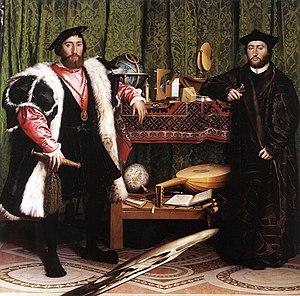How does art mirror society?
Artist : Hans Holbein the Younger
Year : 1533
Type : oil on Oak
Year : 1533
Type : oil on Oak
One of the famous painting from Renaissance is The Ambassadors (1533), which is painted by Hans Holbein the Younger. He used Oil on Oak to do this painting. As well as being a double portrait, the painting contains a still life of several meticulously rendered objects. It is also an example of anamorphosis in painting and require viewers to reconstitute the image. Holbein used symbols to link his figures to the age of exploration.
The choice for the inclusion of the two figures can be seen as symbolic. The figure on the left is in secular attire while the figure on the right is dressed in clerical clothes. Their flanking of the table, which displays open books, symbols of religious knowledge is therefore symbolic of a unification of capitalism and the Church.
But we can also look at this painting on an other angle and see that the painting contains overtones of religious strife. The conflicts between secular and religious authorities are here represented by the portraits of Jean de Dinteville ( a landowner and later ambassador ) and Georges de Selve ( a bishop ). The commonly accepted symbol of discord, a lute with a broken string, is included next to a hymnbook suggesting strife between scholars ( or Landlords ) and the clergy ( or Church ).
Artist clearly portrays in the painting the unification and rift between rich scholars and church. By using the landlord and bishop with symbols like flanking of the table, books etc artist shows the relationship during the Renaissance period. By symbols of lute with broken strings, the artist also shows the rift that was prevalent during Renaissance time between scholars and clergy.
Painting by Hans Holbein the Younger The Ambassadors reflects the interaction between different groups in the society during Renaissance time. By portraying two people from different groups of society and using symbols, Holbein managed to convey the unification and rift at the same time.
But we can also look at this painting on an other angle and see that the painting contains overtones of religious strife. The conflicts between secular and religious authorities are here represented by the portraits of Jean de Dinteville ( a landowner and later ambassador ) and Georges de Selve ( a bishop ). The commonly accepted symbol of discord, a lute with a broken string, is included next to a hymnbook suggesting strife between scholars ( or Landlords ) and the clergy ( or Church ).
Artist clearly portrays in the painting the unification and rift between rich scholars and church. By using the landlord and bishop with symbols like flanking of the table, books etc artist shows the relationship during the Renaissance period. By symbols of lute with broken strings, the artist also shows the rift that was prevalent during Renaissance time between scholars and clergy.
Painting by Hans Holbein the Younger The Ambassadors reflects the interaction between different groups in the society during Renaissance time. By portraying two people from different groups of society and using symbols, Holbein managed to convey the unification and rift at the same time.


